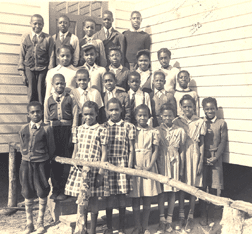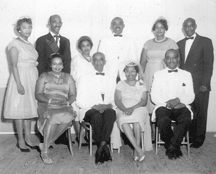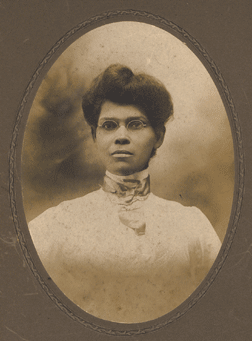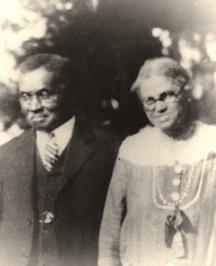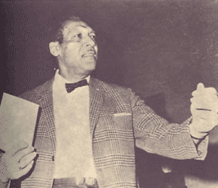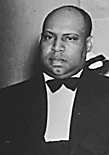|
|||||||||||
|
|||||||||||
|
|||||||||||
African Americans Paving the WayMapping the routes of Maryland’s black history by Diana Beechener
‘I was born and raised right in the neighborhood. Out of 76 years I’ve only spent 13 off of this road.’—Phyllis Queen Matthews.
Weaving through rush hour traffic while cursing at the driver next to you does not leave the average commuter a lot of time for historic ruminations. Passing white-lettered green signs, who has time to think of the people for whom boulevards are named and avenues titled? The observant motorist, however, can travel through African American history in Maryland by taking a careful route through Anne Arundel and Calvert Counties. This navigational name game doesn’t stop at the exit ramps on major roadways. Many small stretches of asphalt bear the names of people who shaped and settled the community. Over time, their pictures and stories fade into the din of our collective history, but their names remain. These descendants of slaves owned property, ran businesses and influenced people. Glossed over by mainstream history books, the everyday history of Maryland’s black communities is signed on small lanes, boulevards and roads throughout the state. Street signs serving as monuments are displayed all day at intersections, illuminated by headlights and streetlamps. Starting in Anne Arundel County and cruising south to Calvert, Bay Weekly leads you on a tour honoring the black citizens who lent their names to the counties’ green street signs.
Anne Arundel CountyImported as chattel on cramped slave ships that docked in Annapolis, African Americans were Anne Arundel County’s silent 41.8 percent according to a 1775 census. Earning their freedom, they settled into communities, ran businesses and strove for equality. Their history was told by families and churches rather than books. In modern times, The Banneker-Douglass Museum helps preserve this overshadowed history. Defining five heroes of Maryland — Benjamin Banneker, Frederick Douglass, Harriet Tubman, Matthew Henson and Thurgood Marshall —Banneker-Douglass honors the most famous members of Maryland’s African American community and brings their accomplishments to new light. The Kunta Kinte-Alex Haley Foundation takes historic collection a step further, inviting communities to share their stories. The foundation focuses on connecting the memories of the older generation with the abilities of Maryland’s youth. “What we’ve found is that [kids] know very little about their family’s history. So by matching them with their elderly relatives or grandparents, we bridge a generation gap and collect more history,” says Judy Cabral, vice president of programs and research for the Foundation. Until museums can gather and find room for the thousands of untold stories that lie dormant in the county, Anne Arundel streets are the most prominent record. These county streets preserve the names of prosperous farmers, free communities, dedicated teachers, shrewd businessmen and at least one statesman.
Queenstown Road The journey toward Calvert County begins at Queenstown Road, running parallel to Baltimore-Washington International Thurgood Marshall Airport’s southern tip on the northern end of Glen Burnie. For just over a mile, the road is bordered by communities and rolling farmland. African Americans first acquired the land in 1880, when a German woman remembered as Mamma Lula gave the lands to her daughter Annie V. upon her marriage into the Queen family. “Farming was our family business,” says Phyllis Queen Matthews, a 76-year-old resident of Queenstown Road and Mamma Lula’s great granddaughter. “My father [Asa Queen] and uncle [Mahlon Queen] sold vegetables year-round to the stores in Baltimore. That was our income.” Matthews still lives on her grandmother’s land, where she and her cousins joined the two previous generations in the fields, harvesting tomatoes, cantaloupes, sweet potatoes and other crops. As the land proved fruitful, other African American families — notably the Gaithers — purchased adjoining plots and expanded the farming community. To spare their children an 11-mile hike to school, Sarah Queen Gaither and her husband Oscar donated a plot of land to the Rosenwald School Initiative in 1932. Funded by Julius Rosenwald, an early partner in Sears, Roebuck & Company, the initiative built 4,977 elementary schools — including the Queenstown School — in black communities between 1912 and 1932. To save their souls, the Queens offered up a piece of land for the Metropolitan Church. “Where Metropolitan church is, I used to work in that field,” says Matthews. As the neighborhood expanded, so did the Queens’ business, from farming to transportation. “My uncles, Arthur and John Queen, owned the first black school buses in Anne Arundel County. They transported the kids to Bates High School.” Over the years, Queenstown has transitioned from quiet farmland to a suburban community. The Queens, however, are a constant: The descendants of Annie V. Queen still live on both sides of Queenstown Road. “I was born and raised right in the neighborhood. Out of 76 years I’ve only spent 13 off of this road,” says Matthews.
Freetown Road A winding strip of road that borders suburban settlements, sparse woods and an open park with basketball courts, Freetown Road cuts a crescent through Marley Neck. The road, named after an old African American settlement, intersects roads named for its founders: the Spencer and Kess families. A Spencer’s scion, Tony, is 21st century Annapolis’ human resources coordinator and historian of the family. Born a free man, James Spencer began Freetown with his 1845 purchase of 56-acre swamp tract of land in Marley Neck. His acreage bordered slave-labor farms. Spencer and his wife Harriet turned their 56-acre swamp into farmland, working along side other free blacks who purchased neighboring lands. James left the land to fight in the Civil War and returned determined to expand these free farms into a town. As Tony tells it, Spencer joined with six landowners — John Owens, Robert Curry, Pathan Owens, Edmond Franklin, William Turner and William Harwood — to purchase a half-acre of land. This one-dollar purchase became the foundation for Marley Neck School. More expensive land followed, as the founders of Freetown purchased 250 acres of surrounding land to develop fields and homes for African Americans in the county. Kirby Lane In Annapolis, a block east of Old Solomons Road on West Street, a small inlet bears the names of African Americans who lived in this residential area. Hicks Avenue runs into Dorsey Avenue, winding around to Kirby Lane. King’s Apostle Holiness Church sits at the mouth of the lane, watching over a sleepy street dotted with residences. No more than 500 feet in length, the small stretch of pavement is named after a country teacher. In post-Civil War Maryland, Ella Tongue Kirby lived in Mt. Zion, in Southern Anne Arundel County. In those years, a scant number of African American schools began in Maryland, but qualified teachers were rare commodities. Recruited as an educator in the 1870s, Kirby took her position seriously. Braving frigid Maryland winters and snowy roads, she trundled many miles from her home to her Tracy’s Landing schoolroom on horseback. Her story is preserved in Annapolitan Philip Brown’s book A Century of “Separate But Equal” Education in Anne Arundel County.
Brown Street Drawing a perpendicular line from West Street to Spa Road, Brown Street cuts a path through a heavily trafficked section of Annapolis. William H. Brown knew the value of hard work and a good education. Brown came to Annapolis in the early 1880s, starting a grocery store and a fuel business in two locations in Annapolis. His first store stood at the corner of West Street and Spa Road. Brown owned his store, sharing the building with a Greek family named Leanos. “A Greek immigrant and William Brown of African descent owned and operated their businesses and coexisted for over 40 years on that corner,” Brown’s grandson, Errol — a second-generation local historian — recalls. Errol Brown followed in his father Philip’s footsteps, collecting stories and images from the Browns and other members of Annapolis’ African American community. His father’s memories of life at the store provided Brown with precious source material. “My father had to work for the family business,” says Brown. William Brown’s sons were put to work in Brown’s burgeoning coal business. “A railroad car of coal would come to Annapolis from Baltimore. My father would have to unload the coal by hand in 24 hours. He unloaded it into their yard, on Spa Road, right where the circle is,” says Brown. “We look at my grandfather as being someone who wasn’t necessarily ahead of his time, but being a man with very limited education, he was able to understand what America was about,” says Brown. “He was able to educate his children. Five of his 10 children went to college.” Brown Street flows into Spa Road just south of Westgate Circle, but a quick detour around the man-made structure reveals a plaque dedicating the adjacent park to the Brown and Leanos families — a tribute to two stores that operated separately but equally.
Aris T. Allen Boulevard Currently a congested 2.7-mile speedway that frustrates motorists between Route 50 and Forest Drive, Aris T. Allen Boulevard was named for the doctor and politician who spared a small community from being split by this heavily trafficked piece of pavement. Originally intended as a way to widen Forest Drive, the developer’s plans would have paved over yards and leveled homes. Allen lobbied instead for a road connecting Forest Drive at Chinquapin Round. Before lending his name to a busy highway spur, Aris. T. Allen graduated from Howard University medical school, setting up a practice in 1945 Annapolis. The doctor never turned away a patient, accepting payment in the form of cash, barter or a plate of baked goods. Dr. Allen’s dedication to his practice was not appreciated by all of his patients. “Allen was my family doctor and very close friends with my mother and father,” recalls Errol Brown. “In the 1950s, I was sick for a few days and, of course, my father called Dr. Allen to the scene. He examined me, wrote a prescription and told my father that [he] would be back. A few days later, his wife [also a doctor] showed up. She comes in, takes my temperature. She reached in her bag —I’m watching her — and pulled out a needle bigger than life. She hit me with that needle and I can truly say that I got well real quick.” After serving his country in the Korean War, Allen entered into a life of public service as a Republican delegate and state senator. Allen solidified his place in Maryland history when he was selected as the first African American head of the state’s Republican party in 1978. He made an unsuccessful bid for lieutenant governor the same year. “Many people switched their [political] affiliation to match his,” says Brown. Though Allen lost the election, he won the presidency of Anne Arundel Medical Center’s staff. A bust of Dr. Allen is nestled at the end of the boulevard, just off of Chinquapin Round.
Calvert CountyHistoric records capture slave ships sailing up St. Leonard Creek as early as 1697, when the Ffly delivered Africans to Calverton settlements. By 1850, black people made up 62.4 percent of Calvert County, slaving on tobacco farms and tilling the county’s rich soil. After the Civil War, free black men share cropped or bought sections of land to work. Many free African Americans migrated from the county, lured by job opportunities in Annapolis and Baltimore, until today the combined minority population has dwindled to 13 percent. Details for these roadways are buried deeper in the county’s memory, making hard facts scarce until more historians step forward. From Bay Weekly’s research, five names recurred in Calvert’s collective roadways. Street names throughout Calvert hold reminders of a unique business woman, a devoted parish, an innovative architect, a freethinking teacher and two freed men.
Christiana Parran Road Stretching south from Dalrymple Road to join with Route 261, Christiana Parran Road cuts a paved swath through nearly two miles of farmland and woods in Chesapeake Beach. Namesake Christiana Parran spent the late 19th and early 20th centuries amassing land in Calvert County. “She was a post mistress and a merchant,” says Kirsti Uunila, Calvert County’s Historic Preservation Planner. “She accumulated a lot of wealth and land through collecting on the extension of credit to people.” The family name thrived in Calvert County, where it is still prominent.
Johns Chapel Road Running off Route 262 in Lower Marlboro, Johns Chapel Road paves over 2,000 feet through a rural area. The road was once the main artery of an African American community. Named after a Methodist church — St. John’s — the road and a Civil War-era cemetery that lies by the roadside are the only evidence of the once-thriving community center, place of worship and schoolhouse. According to the Calvert Historical Society, Preacher John Ross helped establish St. John’s in the late 1800s. The church became a community center, where people gathered to praise God, celebrate life and share gossip. St. John’s committed to saving minds along with souls when the congregation built a small schoolhouse on church lands, constructed before Calvert County thought to educate African Americans. “The school portion of the church was deeded to Calvert Public schools in the 1920s,” says Uunila. Decades later, the county abandoned the small schoolhouse, leaving it to crumble next to the church that donated its land. The 1960s held more misfortune for the church. As Uunila tells it, the church burned down — though a reason for the fire couldn’t be found. The parish rallied and attempted to rebuild, but the church burned again within the decade. “All that remains now is a flooded ruin,” says Uunila. Next to the gaping hole left by the church is the parish’s cemetery, a roadside resting place for the congregation that built the area. Cassell Boulevard The lifeline of a suburban community, Cassell Boulevard stretches north from Dares Beach Road, feeding traffic in and out of the Prince Frederick neighborhood. Running just under two miles, the road bears the name of a renowned architect who dreamed of building a self-sustaining African American community. Born in Towson Maryland, Albert Cassell ventured to Ithaca, New York, for a better high school education. Thriving in a challenging academic environment, he entered Cornell University and earned his degree in architecture — after a brief absence to serve in the Great War. Cassell journeyed back to the south to design trade buildings at the Tuskegee Institute. Completing the job in 1920, Cassell took a position at Howard University as an assistant professor. The university credits him with leaving an indelible mark on the campus: Cassell helped build the University’s master plan and, most famously, designed the Founders Library and the Hilltop Campus. He left the university in 1938, to pursue his dream — a planned community for African Americans. “He had included a factory, housing, schools, amenities, recreation and a water system,” says Uunila. “He even designed houses.” Cassell bought nearly 500 acres in the Dares Beach area to build his dream. The county government did not share his vision, denying Cassell permits and preventing him from breaking ground. “He was blocked at every turn by county government,” says Uunila. Cassell’s poor health and advanced years helped the county win its battle. The architect laid his dream to rest in the 1940s. Stamper Court Stretching south off of Harriet Tubman Street, Stamper Court is the main road in an affordable housing community near Prince Frederick’s Main Street. The 400-foot span of asphalt bears the name of a teacher who fortified minds and built homes. Graduating from Hampton Institute in 1940, 21-year-old Ailene Stamper moved to Calvert County to teach in a segregated school for African American children. Stamper’s goal was to have all her charges complete school and attend college. Her dogged commitment to education led to her appointment as interim principal of W.S. Brooks High School in 1943. Her quest for academic excellence led to job opportunities at Penn State and government institutes. Stamper turned down these prestigious jobs, citing her need to improve Calvert County’s public education system. Balking at the typical treatment of African American teachers, Stamper transformed a portion of her lands into a teacherage. On $10 worth of Prince Frederick land bought from Arthur and Lucretia Dowell, Stamper built Central Village. Originally a few rooms that she rented to fellow teachers, Central Village grew with her lands, forming a small community. The Maryland Historic Trust lists Central Village and the Stamper house as the only standing African American teacherages in Calvert County. The footprints of Central Village rest on Central Village Drive, off Dares Beach Road. Stamper’s commitment to education and her vision of equal housing kept the teacher a local hero and inspiration until her death in 2004.
Mason Road The final road on this journey south curves off Hallowing Point Road, running just over 2,000 feet in a suburban community. Mason Road took its name from two brothers born into slavery who found their freedom in Calvert County’s rich farmland. Though their lives were not their own, the Mason brothers managed to save money. “They earned money on the side,” says Uunila. After the Civil War, white-run farms faced a budget crisis; with slave labor gone, farmers could no longer afford to reap the benefits of the land. Bankrupt, some whites deeded their property to the African Americans once forced to farm it. The Mason family took advantage of this historic irony, purchasing 300 acres of former slave-tilled land. “The land wasn’t farmed,” says Uunila. “The majority of it was broken into property lots where the Mason brothers’ family still lives.”
The roads range from sleek speedways to rural patches of asphalt, but each is a footprint of African American culture in Maryland. Some roads took their names from city resolutions and the State Highway administration, but other roads kept the names printed on handmade signs that flanked rural dirt thruways. As Banneker-Douglass and the Kunta Kinte-Alex Haley Foundation continue their quest to preserve an oft-forgotten part of American history, street signs serve as reminders of those people and communities that fought for equality and freedom. A green and white tribute to the small stories of African American culture, not always found in museums — but not forgotten as they watch over our roads.
The Roads Not Taken The 10 streets in the story are the tip of the historic iceberg. These streets are also named after African Americans. For more, we depend on your knowledge. We welcome all you can tell us, and with it promise a second installment of this story. Write [email protected]. Anne Arundel County: Douglass Avenue Sherman Bouyor Lane Glens Road Whites Road Conway Road Belts Road Bunche Street Matthewstown Road Dorsey Avenue Dorsey Drive Davis Street Hicks Avenue Carroll Hynson Street Bowman Court Spencer Road Howard Street Kess Circle Magothy Camp Meeting Halle Parkway Scottown Lane Nick Lane
Calvert County: Bourne Road Collins Court David Gray Road Dorothy Johnson Court Hutchins Road Kyler Road Mandela Court Thomas Gantt Road Toye Lane
Special thanks to my first-hand and historical sources: Errol Brown Sr.; Kirsti Uunila of Calvert County Historic Preservation; Joni Jones and Phyllis Queen Matthews; Tony Spencer; Denise Cherry and Karen Sykes of the Calvert Historical Society; Carmen Caswell, Cindy Hackett and the Annapolis Public Library; Judy Cabral of the Kunta Kinte-Alex Haley Foundation; Margaret Tearman.
Census Source: www.kinta-haley.org. Calvert County History: www.co.cal.md.us/assets/Planning_Zoning/HDC/AfricanAmericanHistorySlideshow.pdf
|
|||||||||||
|
|||||||||||
|
|
|||||||||||
|
© COPYRIGHT 2008 by New Bay Enterprises, Inc. All rights reserved.
|
|||||||||||


